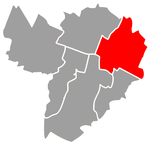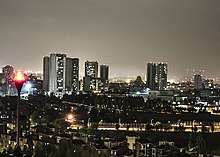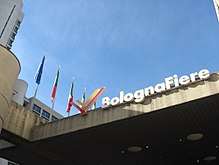Fiera District
Fiera District is the business district of Bologna, Italy. The area is home to a major trade exhibition centre and features several office towers occupied by the regional government of Emilia-Romagna and different private companies.

History
19th century
The history of Bologna's Fiera District begins in the 19th century. The first large trade fair was held in the city on May 7, 1888 in Giardini Margherita, inaugurated by King Umberto I, Queen Margherita of Savoy and the then Prime Minister, Francesco Crispi.[1][2]
20th century


Trade fairs of national significance were held more constantly starting from 1927, the year in which the "Littoriale" football stadium, now Renato Dall'Ara Memorial Stadium, was built by the Fascist regime, with expositions taking place inside the stadium on a regular basis.[3][4]
After WW2, in 1947, the local chamber of commerce set up an Autonomous Fair Company ("Ente Autonomo delle Fiere di Bologna", EAF); however, it didn't have a fixed location yet, but trade fairs were held between Montagnola park and Palazzo del Podestà.[5]
In 1961 EAF launched a contest in order to select a project for a first block of permanent pavillons.[6] The winning project was that of architects Leonardo Benevolo, Tommaso Giuralongo and Carlo Melogran;[7] works began in 1964 and the following year the 29th Fair of Bologna, inaugurated by the then Prime Minister Aldo Moro, was the first to be held in a permanent venue.[8]
At the end of the 1960s the city authorities, worried by massive gentrification and suburbanisation, asked Japanese archistar Kenzo Tange to sketch a master plan for a new town north of Bologna; however, the project that came out in 1970 was evaluated as way too much ambitious and expensive.[9] Eventually the city council, in spite of vetoing Tange's master plan, decided to keep his project for a new exhibition centre and business district.[10] At the end of 1978 the construction of a tower block and several diverse buildings and structures started.[11] In 1985 the headquarters of the regional government of Emilia-Romagna moved in the new district.[12]
21st century
In 2002 EAF turned into "BolognaFiere Spa", a joint-stock company that is the fulcrum of a regional fair system that includes also Modena and Ferrara, with a combined total of 200,000 square meters of gross hall capacity,[13] of which 105,000 in Bologna alone.[14]
In 2010 a new 22 story, 90 meters high tower has been completed.[15]
At the end of 2016 BolognaFiere Spa successfully carried out a €20m seasoned equity offering with the aim to expand its exhibition grounds to 140,000 square meters.[16] On October 30, 2017 (after the approval of a new €100m restyling project) demolition works of the old pavillons officially started.[17]
See also
References
- ""Chronology of Bologna: 1888" (in Italian)". www.bibliotecasalaborsa.it. Salaborsa Library. Retrieved 30 November 2017.
- Dondarini, Rolando (2007). Storia illustrata di Bologna. Ospedaletto (Pisa): Pacini. ISBN 9788877818843.
- ""Chronology of Bologna: 1927" (in Italian)". www.bibliotecasalaborsa.it. Salaborsa Library. Retrieved 30 November 2017.
- Quercioli, Giuseppe (2006). Bologna e il suo stadio : ottant'anni dal Littoriale al Dall'Ara : la storia di un grande monumento della città. Bologna: Pendragon. ISBN 978-8883424991.
- ""Chronology of Bologna: 1947" (in Italian)". www.bibliotecasalaborsa.it. Salaborsa Library. Retrieved 30 November 2017.
- ""Chronology of Bologna: 1927" (in Italian)". www.bibliotecasalaborsa.it. Salaborsa Library. Retrieved 30 November 2017.
- ""I Padiglioni" (in Italian)". www.bolognafiere.it. Bologna Fiere. Retrieved 30 November 2017.
- ""Chronology of Bologna: 1927" (in Italian)". www.bibliotecasalaborsa.it. Salaborsa Library. Retrieved 30 November 2017.
- Heath, Tim; et al. (2001). Revitalizing historic urban quarters (Reprinted ed.). Oxford: Architectural Press. p. 107. ISBN 978-0750628907.
- Ghirardo, Diane Yvonne (2013). Italy: Modern Architectures in History (1. publ. ed.). London: Reaktion. p. 283. ISBN 978-1861898647.
- ""Chronology of Bologna: 1927" (in Italian)". www.bibliotecasalaborsa.it. Salaborsa Library. Retrieved 30 November 2017.
- ""La Regione e la sua storia - le sedi della regione" (in Italian)". www.regione.emilia-romagna.it. Emilia-Romagna region. Retrieved 1 December 2017.
- "Ranking of the world's largest exhibition halls in 2017, by gross hall capacity (in square meters)". www.statista.com. Statista. Retrieved 1 December 2017.
- Vesentini, Ilaria (23 September 2016). ""Fiera di Bologna, tra un anno il restyling da 60 milioni di euro" (in Italian)". Il Sole 24 Ore. Retrieved 1 December 2017.
- ""Nuova torre per uffici della Regione Emilia-Romagna nel Fiera District di Bologna" (in Italian)" (PDF). Finanziaria Bologna Metropolitana Spa. Retrieved 1 December 2017.
- Visentini, Ilaria (19 December 2016). ""BolognaFiere, al via piano industriale e aumento di capitale" (in Italian)". Il Sole 24 Ore. Retrieved 1 December 2017.
- "And so begins the demolition - the start of the BolognaFiere's new hall development!". www.bolognafiere.it. BolognaFiere. Retrieved 1 December 2017.